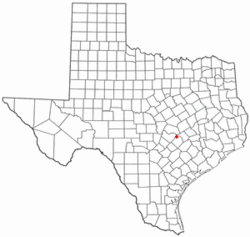Elgin, Texas
| Elgin, Texas | |
|---|---|
| City | |

Elgin Courier building
|
|
| Nickname(s): Brick Capital of the Southwest; Sausage Capital of Texas |
|
| Motto: "Perfectly Situated" | |
 Location of Elgin, Texas |
|
 |
|
| Coordinates: 30°20′55″N 97°22′21″W / 30.34861°N 97.37250°WCoordinates: 30°20′55″N 97°22′21″W / 30.34861°N 97.37250°W | |
| Country | United States |
| State |
|
| Counties | Bastrop, Travis |
| Government | |
| • Type |
Home Rule, Council-Manager form |
| • Mayor-at-Large | Chris Cannon |
| • City Council |
City Council
|
| Area | |
| • Total | 5.8 sq mi (15.0 km2) |
| • Land | 5.8 sq mi (15.0 km2) |
| • Water | 0.0 sq mi (0.0 km2) |
| Elevation | 581 ft (177 m) |
| Population (2010) | |
| • Total | 8,135 |
| • Density | 1,400/sq mi (540/km2) |
| Time zone | Central (CST) (UTC-6) |
| • Summer (DST) | CDT (UTC-5) |
| ZIP code | 78621 |
| Area code(s) | 512 & 737 |
| FIPS code | 48-23044 |
| GNIS feature ID | 1373617 |
| Website | elgintx |
Elgin (/ˈɛlɡᵻn/ ELG-in, unlike Elgin, Illinois) is a city in Bastrop and Travis Counties in the U.S. state of Texas. The population was 8,135 at the 2010 census. The city is a suburb of Austin, and is part of the Greater Austin metropolitan area. Elgin is also known as the Sausage Capital of Texas and the Brick Capital of the Southwest, due to the presence of three operating brickyards in the mid-20th century (two of which are open to this date).
The City of Elgin owes its existence to a major flood of the Colorado River in 1869. Originally, the railroad was to have run from McDade, 10 miles (16 km) east of Elgin, southwest to the Colorado River at a point somewhere between Bastrop and Webberville, then to Austin following the river.
In 1871, the Houston and Texas Central Railroad (succeeded by the Southern Pacific Transportation Company) built through the area and established a flag stop called Glasscock named for George W. Glasscock, a local resident and Republic of Texas soldier who lived in the area in the 1830s. Glasscock was renamed on August 18, 1872, for Robert Morris Elgin, the railroad's land commissioner, following the practice of naming new railroad towns after officers of the company. Elgin was established. The original plat placed the train depot in the center of a one-square-mile area.
...
Wikipedia
